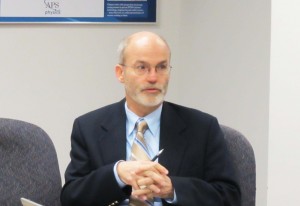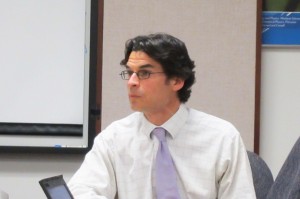The Global Design Effort (GDE) Executive Committee met for a face-to-face meeting in the Washington DC offices of the American Physical Society from 8-9 February. At that meeting, we invited some guests to inform us about how science policy and funding work in the US government. Our mandate for the GDE is soon approaching its final milestone, the delivery of a Technical Design Report (TDR). In fact, the US President’s FY2013 budget submission to Congress, the starting point for the yearly US budget process, contains no ILC follow-on funding beyond the TDR! The budget language recognises the accomplishments of the GDE and the anticipated successful completion of the ILC TDR at the end of this year. Nevertheless, it is clear that a new approach will be required to obtain continued funding towards an ILC project.
We had a very interesting session with Francis Slakey, the American Physical Society (APS) Associate Director for Public Affairs. He explained the role the APS plays in affecting US science policy and in advocating for science funding. Francis used a recent example of a study carried out by the APS Panel on Public Affairs in collaboration with the Material Research Society titled Energy Critical Elements. The study illustrates how the APS addresses important science policy issues, calling on experts in their membership (and beyond) to carry out targeted studies. He explained how specific recommendations from such a study can be used to influence government science policy. This particular study, which focussed on energy-critical elements used in emerging technologies, analysed the needs for critical elements and how to ensure their availability. Such critical elements include, for example, tellurium used in solar panels, lithium used in wind turbines and batteries in hybrid cars, terbium used in compact fluorescent bulbs to provide colour balance, and other such new technologies. Slakey pointed out that based on the recommendations from this study, there is now new legislation pending in Congress.
In addition to the APS work on science policy issues, Slakey described the various steps involved in the US budget cycle and how the process works. He also traced the history of last year’s science budgets, identifying areas where APS and other science advocacy groups were able to gather support to restore science budget cuts, even in a year where the overall US budget was under severe pressure.

Jerry Blazey, Assistant Director for Physical Sciences at the Office of Science and Technology Policy
Jerry Blazey, who is very familiar to those of us in the ILC GDE (he previously served at the DOE Office of High Energy Physics with responsibility for the ILC R&D programme), is now Assistant Director for Physical Sciences in the Office of Science and Technology Policy (OSTP). OSTP advises the President on science and technology issues, both domestic and international. Jerry explained the administration’s stated views regarding international collaboration, emphasising the desire of the Obama administration to develop international partnerships. He also pointed out some of the priorities of the administration, and noted how a project like the ILC might fit into such overall priorities.
The perspectives given to us by Drs. Blazey and Slakey were very informative, especially as we consider how our long-term programme can continue on a path towards an ILC project, following submission of the TDR. Although the immediate goal of the GDE is focussed on producing a solid and viable technical design, we all recognise that mapping out the next steps towards a real ILC project must be addressed and will be a major challenge. The problem is simply how to approach the very likely interim period of several years before a linear collider can be proposed and funded with a programme that will advance the ILC technically, while at the same time be intrinsically justifiable.



Recent Comments